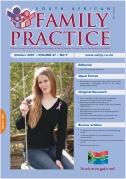Drugs in Aviation - A Review
Abstract
The Aviation Medicine Department of the South African Civil Aviation Authority (SACAA), Aviation Medical Examiners (AME), and Institute for Aviation Medicine (IAM) receive numerous inquiries regarding the use of medication in the aviation environment. Flying an aircraft or controlling aircraft on the ground are highly demanding cognitive and psychomotor tasks, performed in an often inhospitable environment, with exposure to various sources of stress. It is therefore important for aviation personnel (i.e. aviation medical examiners, pilots, cabin crew and air traffic services personnel) to consider the effects that medicine or drugs may have on performance. Studies confirm that some pilots, and other crew members while on duty, used prohibited medications or illegal substances or performed duties while suffering significant unreported medical conditions. When considering aircraft mishaps and their causes, we tend to focus on the pilot. After all, he’s in the driver’s seat, there to troubleshoot any problems that may arise, and he’s expected to bring the “on-loan aircraft back to base, in one piece, after a mission. If a mishap occurs, investigators look for causes related to pilot error along with evidence of mechanical failure, weather factors, and runway condition and air traffic control (ATC) issues. Reviews of data from general aviation, commercial and military aircraft mishaps show that the two most often cited causal issues are pilot error and mechanical/logistical factors. If pilot error was identified, the question now arises: Are some instances of incorrect controlling of an aircraft due to human factors, such as poor diet or insufficient rest (self-imposed), fatigue, poor concentration, shift-work problems, inadequate training or lack of motivation? More specifically, the following in terms of pilot error have been identified in the USA: • Flying under the influence of alcohol – 15% • Conducting unwarranted manoeuvers – 30% • Penetrating known adverse weather conditions beyond pilot and aircraft capabilities – 40% • Drug impairment of the pilot (includes prescribed medication) – 6% • Miscellaneous – 9% Although these statistics relate to the pilot, they can no doubt be extended to other aviation personnel e.g. ATC, cabin crew (CC) and aircraft maintenance officers (AMO). Of note is that up to 6% of aircrew are ‘under the influence of medication’ while operating an aircraft. Aircrew, like all of us, are prone to illness, but those who take medicine on an inadequately informed basis or undertake self-medication, not only endanger their lives but also jeopardise the safety of passengers and costly aircraft. The Aviation Medicine Department of the South African Civil Aviation Authority, Aviation Medical Examiners, and the Institute for Aviation Medicine receive numerous inquiries regarding the use of medication in the aviation environment. In addition, reports have been received relating to aviation personnel using unapproved medication or illegal drugs. Furthermore, a physician may prescribe medication for a patient while being unaware that the patient is performing duties within the aviation environment. Or, a pilot self-medicates because consulting an AME may result in flying privileges being withdrawn. Flying an aircraft or controlling aircraft on the ground are highly demanding cognitive and psychomotor tasks, performed in an inhospitable environment, with exposure to various sources of stress. It is therefore important for aviation personnel (i.e. aviation medical examiners, pilots, cabin crew and air traffic controllers) and non-aviation medical examiners to consider the effect that medicine or drugs may have on aviation performance. A study performed in 1994 by the FAA revealed that an estimated 14 000 US pilots flew while using prohibited medications or illegal substances or flew with significant unreported medical conditions. Greater understanding of the effects of medication in humans, and advances in drug development have now made possible the use of various medications by aircrew. In this context assessment of side effects which a drug may have on performance, has become an important part of its clinical profile and provides increased and more informed availability of potential therapy for aircrew. The aim of this review is to make the non-aviation medical examiner aware of, and to provide an understanding of the issues involved rather than to provide recommendations for drug use in aviation and to outline the various approaches that can be adopted to assess whether a drug can be used safely.
Section
Review Articles
By submitting manuscripts to SAFP, authors of original articles are assigning copyright to the South African Academy of Family Physicians. Copyright of review articles are assigned to the Publisher, Medpharm Publications (Pty) Ltd, unless otherwise specified. Authors may use their own work after publication without written permission, provided they acknowledge the original source. Individuals and academic institutions may freely copy and distribute articles published in SAFP for educational and research purposes without obtaining permission.

